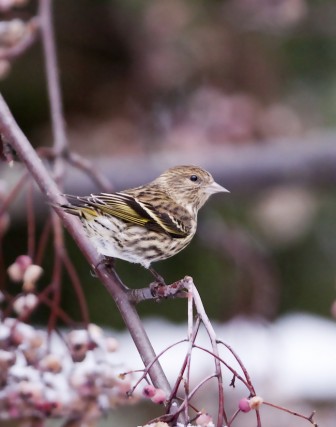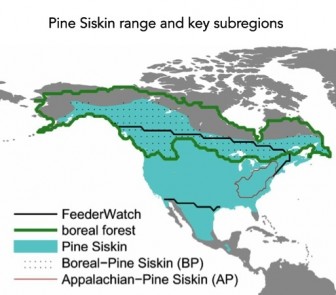
Perched pine siskin. Image: Flickr, Rick Leche
Citizen science research is helping tell the story of one small songbird and its offbeat migration behavior.
The nomadic pine siskin follows its food from forest to feeder.
“Bird-watchers will notice their feeders completely overrun by the siskin one winter, and almost completely without them the next,” said Ben Zuckerberg, the project’s coauthor and avian ecologist at the University of Wisconsin-Madison.
Unlike most bird species, siskins can choose whether to migrate. And scientists suggest their decision to migrate in great numbers — known as irruption — is signaled by climate.
The seed-eating siskins’ population booms are due to variations in weather and the availability of food, Zuckerberg said.
“There’s a massive resource pull associated with the boom and bust of forest seed production,” he said.
When siskins find enough conifer seeds, they will stick around the Canadian boreal forest, which stretches across the continent, into winter. In other years, siskins are pushed south for seed.
“Some movements are periodic, every two years. And others are decadal irruption events where it’s very obvious, called super flight years,” Zuckerberg said.
Scientists suggest the biggest population variations happen on and after years where conifers produce massive amounts of seed, called a mast year. But scientists still debate the reason for these mast years.
“The birds will eat all the seed in mast years, having multiple nests and many young, and then comes the next year, the bust year,” Zuckerberg said.
With too many young and not enough seed, siskins begin to look elsewhere for food.

Pine siskin range marked in blue. Black contours show the northern and southern edges of the FeederWatch observation data. Image: Court Strong, National Academy of Sciences
“The driver could be a combination of factors, the masting behavior and seed production are likely, but then weather can play a role directly or indirectly, making it tricky to figure out,” said Walt Koenig, coauthor and research scientist at Cornell’s Lab of Ornithology.
Nearly a dozen seed-eating boreal birds exhibit the migration phenomenon, but the common and easily identifiable pine siskin has a wide enough range to combine the weather factor.
“We approached the data from bird counts similar to the way we approach climate data and revealed how they were linked,” said Courtenay Strong, the study’s climatologist.
Climate scientists like Strong are accustomed to working with big datasets that can span continents, but “those datasets are rare in biology,” he said.
The wide, geographic range of species makes it difficult for researchers to collect this data, however citizen science projects are popularizing the use of remote observations from volunteers.
Non-scientist volunteers counted the small, brown-streaked pine siskin as part of Cornell University’s Project FeederWatch, a citizen-based winter survey of birds throughout North America.
Over two million siskins were counted, providing scientists with a dataset comparable to existing ones for climate despite potential miscounts by FeederWatch volunteers.
Siskins are not hardwired like other migrants — timing, directions and distances vary for their migration, Zuckerberg said.
But the pattern is becoming clearer for scientists, who can now use temperature and precipitation data to help predict a mass migration event one to two years before it happens.

Pine siskin flock. Image: Flickr, Putney Design
“When you see a pattern in this kind of dataset, it must be a really strong pattern in order to rise above some of the issues associated with a large dataset and a large number of contributors,” Strong said.
The cross-continent movement of siskins occurs after boom years, when the young birds are looking for food and are pushed along either of two weather-driven migration paths.
One of them is like a pendulum, “an east-to-west irruption mode” across the United States Canadian border, Zuckerberg said. “It was always presumed but never documented until now.”
And the other is “a striking north-to-south irruption mode, where the birds leave boreal Canada and move south into the Appalachians,” he said.
This is the first time scientists have revealed how variances in weather can push and pull the species out of the northern conifer forest and south past the Great Lakes region during winter.
“A lot of variation happens near the US-Canadian border. The Great Lakes are within their east-west migration pattern and mark the dividing line between the north and south migration pattern,” Strong said.
Some of this variation can be explained by weather, Koenig said, “but what researchers really want is both the weather and seed production data.”
By combining the two, researchers are getting a better picture of the broad-scale migration phenomenon, even extending their work to other irruptive species.
“We want to explore all these questions, creating legacies through databases. Capturing the fingerprint of climate, this broad biological signal,” Zuckerberg said.
To join Project FeederWatch and contribute to research like this, submit the online membership form for the upcoming FeederWatch season, beginning November 14.